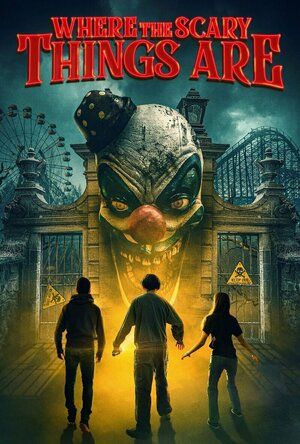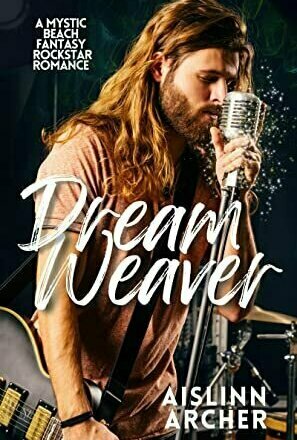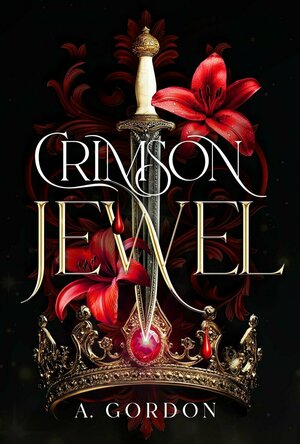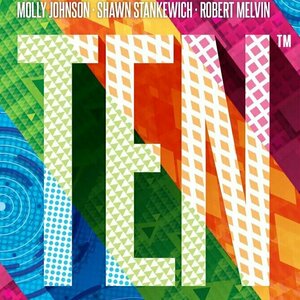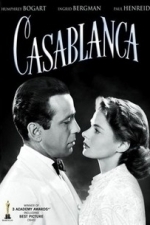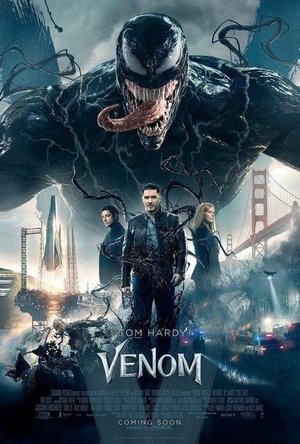Search
Search results
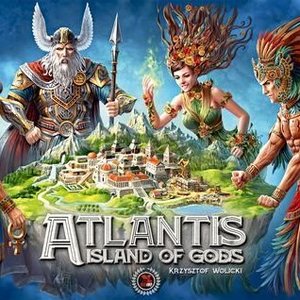
Atlantis: Island of the Gods
Tabletop Game
Before the civilizations that we know of there was a great island, called by contemporary scientists...
Boardgames MythologyGames 2018Games
TheFiend13420 (21 KP) rated Where The Scary Things Are (2022) in Movies
Jun 28, 2022 (Updated Jun 28, 2022)
Excellent performances by virtually unknown cast (2 more)
Well written, fun and flows well
Beauty make-up job on the creature
The Loser's Club these kids are NOT
I have been waiting for this film to come out for months now. And it was totally worth the wait.
A group of friends, led by angry disruptive Ayla, venture out to the closed down Field of Screams Halloween Haunt in search of a local urban legend. Prompted by one of their teachers, They are asked to make up their own Legend and try to bring it to life to prove how false facts can create a sort of mass hysteria. And eventually. They become real... Like local urban legend, Lockjaw.
First off... These fucking kids
None of them are likable. They all have something that makes them horrible. There's no smiles and laughs while walking down the fucking train tracks in this not so feel good movie. The performances by these kids. Even the youngest one... Who you kind of want to kick in the face... puts in a stellar showing. The lead girl. With her serial killer like lack of emotion and empathy. If there were Oscars for horror. She would most definitely be nominated. Even the one kid who shows some form of common sense. Has not one real redeeming quality. These kids are just plain horrid. You literally wish death upon these teenagers
Second. The originality of the whole thing. I know it will probably garner some comparisons to Psycho Goreman. But... Believe me when i tell you... There is no similarity. These are two completely seperate entities.
The idea of Urban Legends coming true. And not being projected by some killer in a parka. makes me extremely happy. Not a slight against the series of Urban Legend movies... I love them... But...
Third. I love the pace of the film. It keeps going, doesn't let up in the slightest. Just when you think you've seen it all. The little bastards just break down the morality wall a little bit more. Such a fun ride to be on.
Was it worth the wait. Absolutely.
Would I recommend it to my friends.... 100%.
Will it be something I'd watch again... I'm actually watching it again... Right now... While I do this review.
Mr. Smith, you've done it again.
You have kept my interest and left me utterly satisfied with an hour and a half of pure horrific pleasure.
Not one stitch of disappointment here...
A group of friends, led by angry disruptive Ayla, venture out to the closed down Field of Screams Halloween Haunt in search of a local urban legend. Prompted by one of their teachers, They are asked to make up their own Legend and try to bring it to life to prove how false facts can create a sort of mass hysteria. And eventually. They become real... Like local urban legend, Lockjaw.
First off... These fucking kids
None of them are likable. They all have something that makes them horrible. There's no smiles and laughs while walking down the fucking train tracks in this not so feel good movie. The performances by these kids. Even the youngest one... Who you kind of want to kick in the face... puts in a stellar showing. The lead girl. With her serial killer like lack of emotion and empathy. If there were Oscars for horror. She would most definitely be nominated. Even the one kid who shows some form of common sense. Has not one real redeeming quality. These kids are just plain horrid. You literally wish death upon these teenagers
Second. The originality of the whole thing. I know it will probably garner some comparisons to Psycho Goreman. But... Believe me when i tell you... There is no similarity. These are two completely seperate entities.
The idea of Urban Legends coming true. And not being projected by some killer in a parka. makes me extremely happy. Not a slight against the series of Urban Legend movies... I love them... But...
Third. I love the pace of the film. It keeps going, doesn't let up in the slightest. Just when you think you've seen it all. The little bastards just break down the morality wall a little bit more. Such a fun ride to be on.
Was it worth the wait. Absolutely.
Would I recommend it to my friends.... 100%.
Will it be something I'd watch again... I'm actually watching it again... Right now... While I do this review.
Mr. Smith, you've done it again.
You have kept my interest and left me utterly satisfied with an hour and a half of pure horrific pleasure.
Not one stitch of disappointment here...
Merissa (13619 KP) rated Dream Weaver (Mystic Beach #2) in Books
Jul 15, 2022 (Updated Jul 17, 2023)
Finally! Finally, we get to see the ending of Hunter and Brighid's story! DREAM WEAVER is the second story in the Mystic Beach series that has Brighid and Hunter as the main characters. Now, I need to say, there wasn't actually a long wait for this book but, being as I wanted to find out what happened as soon as I'd finished book one, it has felt like an age!
Hunter is back in Brighid's life, determined to put all his past wrongs right with her - still as his best friend though. By this time, Brighid is happy to get what she can. Life has a way of happening though, and things definitely don't go smoothly.
One thing that bugged me is Hunter's reaction to Holly's ultimatum. Gah! I wanted to slap him upside the head! He knows Marina is on his side, and he knows Billy will do whatever he can to help, but does he speak to them? No! He falls for the old 'if you tell anyone, I will know' routine. And a blind man could see that Holly would release the video at some point because that's just who she is.
Anyway, moving on LOL. I loved how assumptions Hunter had made about how his bandmates saw Brighid were shot out of the water. In fact, that whole part with him seeing the restrictions he'd placed on them both was brilliantly written. I liked how Brighid turned it around when she was with her circle, to get an honest opinion from them. I understood her reaction but felt as though she'd taken a bit much on her shoulders as her responsibility. How other people speak/act/feel isn't all down to you, but then, I've had this conversation recently with my hubby so that may have bled over into this!
I loved their story and thought the ending was perfect for them. Hunter's tattoo sounds gorgeous and I'm so happy they have finally worked it through. Now I have to wait (im) patiently for the next one. Ah, Ms. Archer, what have you done to me? You've got me hooked on #RockstarRomance when I don't even like it that much! Highly recommended by me.
** same worded review will appear elsewhere **
* A copy of this book was provided to me with no requirements for a review. I voluntarily read this book, and the comments here are my honest opinion. *
Merissa
Archaeolibrarian - I Dig Good Books!
Jul 13, 2022
Hunter is back in Brighid's life, determined to put all his past wrongs right with her - still as his best friend though. By this time, Brighid is happy to get what she can. Life has a way of happening though, and things definitely don't go smoothly.
One thing that bugged me is Hunter's reaction to Holly's ultimatum. Gah! I wanted to slap him upside the head! He knows Marina is on his side, and he knows Billy will do whatever he can to help, but does he speak to them? No! He falls for the old 'if you tell anyone, I will know' routine. And a blind man could see that Holly would release the video at some point because that's just who she is.
Anyway, moving on LOL. I loved how assumptions Hunter had made about how his bandmates saw Brighid were shot out of the water. In fact, that whole part with him seeing the restrictions he'd placed on them both was brilliantly written. I liked how Brighid turned it around when she was with her circle, to get an honest opinion from them. I understood her reaction but felt as though she'd taken a bit much on her shoulders as her responsibility. How other people speak/act/feel isn't all down to you, but then, I've had this conversation recently with my hubby so that may have bled over into this!
I loved their story and thought the ending was perfect for them. Hunter's tattoo sounds gorgeous and I'm so happy they have finally worked it through. Now I have to wait (im) patiently for the next one. Ah, Ms. Archer, what have you done to me? You've got me hooked on #RockstarRomance when I don't even like it that much! Highly recommended by me.
** same worded review will appear elsewhere **
* A copy of this book was provided to me with no requirements for a review. I voluntarily read this book, and the comments here are my honest opinion. *
Merissa
Archaeolibrarian - I Dig Good Books!
Jul 13, 2022
Debbiereadsbook (1623 KP) rated Crimson Jewel in Books
Oct 2, 2025
I wanted Raiden, and I didn't get him!
Independent reviewer for Archaeolibrarian, I was gifted my copy of this book.
The thing I love most about reviewing is finding brand spanking new authors. Finding those new authors who smash it out the park with their first book is just the icing on the cake! This is such a book.
But while I loved this book, I really did, I hated it too. And I'll tell you why in a little bit!
It's a kind of fairy tale retell: Jack and the Beanstalk. I loved the play on words with that.
It's a kind of why choose, but Bea HAS to choose. Except her choice isn't one she is allowed to make, as Raiden forsaked (not sure that's a word, but I'm keeping it!) his First-Born Son status.
Bea has multiple partners, but not at the same time. I liked that she did that, to be honest, and it made the connection she had with Raiden more intense.
It's dark and deadly in places: Bea gets kidnapped, thrown into a ravine, and almost drowned, after all. Someone doesn't want her to make her choice, and I was a little surprised who was behind it.
Not totally surprised, there were some very VERY obvious culprits but a couple threw me!
I really REALLY want there to be more books, about the First-Born Sons and what happens to them! They play a huge part here, even if only for a week or two, but they too need a happy ever after and I hope the author writes them.
So, I loved this book, yes. But as I said, I hated it too. Why??
Single person point of view!
Only Bea gets a say and I wanted, needed, so DESPERATELY needed to hear from Raiden, and I do not get him. I wanted to know what he felt when he first met Bea. When he realised what she had done, and what that meant. When he found out she had been with others before him. And when that happened all at the end (not saying what, for spoilers!) I needed to hear from him when he found out what finally happened to his parents.
And I don't get him and this is the only reason I gave this book . . .
4.5 stars (but rounded UP for the blog!)
Well done, Ms Gordon (apologies if you go by anything else, I couldn't see otherwise!) seriously, VERY well done!
*Same worded review will appear elsewhere
The thing I love most about reviewing is finding brand spanking new authors. Finding those new authors who smash it out the park with their first book is just the icing on the cake! This is such a book.
But while I loved this book, I really did, I hated it too. And I'll tell you why in a little bit!
It's a kind of fairy tale retell: Jack and the Beanstalk. I loved the play on words with that.
It's a kind of why choose, but Bea HAS to choose. Except her choice isn't one she is allowed to make, as Raiden forsaked (not sure that's a word, but I'm keeping it!) his First-Born Son status.
Bea has multiple partners, but not at the same time. I liked that she did that, to be honest, and it made the connection she had with Raiden more intense.
It's dark and deadly in places: Bea gets kidnapped, thrown into a ravine, and almost drowned, after all. Someone doesn't want her to make her choice, and I was a little surprised who was behind it.
Not totally surprised, there were some very VERY obvious culprits but a couple threw me!
I really REALLY want there to be more books, about the First-Born Sons and what happens to them! They play a huge part here, even if only for a week or two, but they too need a happy ever after and I hope the author writes them.
So, I loved this book, yes. But as I said, I hated it too. Why??
Single person point of view!
Only Bea gets a say and I wanted, needed, so DESPERATELY needed to hear from Raiden, and I do not get him. I wanted to know what he felt when he first met Bea. When he realised what she had done, and what that meant. When he found out she had been with others before him. And when that happened all at the end (not saying what, for spoilers!) I needed to hear from him when he found out what finally happened to his parents.
And I don't get him and this is the only reason I gave this book . . .
4.5 stars (but rounded UP for the blog!)
Well done, Ms Gordon (apologies if you go by anything else, I couldn't see otherwise!) seriously, VERY well done!
*Same worded review will appear elsewhere
Purple Phoenix Games (2266 KP) rated TEN in Tabletop Games
Nov 28, 2021
When it comes to game mechanics, set collection is my JAM. Auction/bidding and push your luck, not so much….. So when Alderac Entertainment Group brought TEN into my life, I was a bit wary at first. A game of collecting sequences/sets of numbers? Awesome!! Add in bidding for Wildcards or pushing your luck to not Bust each turn? A bit too risky, at least for my gaming tastes. After having had the opportunity to play TEN, were my initial feelings misplaced? Spoiler: Yes. For me, TEN was a prime example of “Don’t judge a game by its mechanics.” Keep reading to find out why.
Disclaimer: We were provided with a copy of TEN for the purposes of this review. This is a final production copy, so what you see pictured is what you would receive in a retail copy of the game. -L
TEN is a push-your-luck game of set collection and auction/bidding in which players are trying to amass the most points by the end of the game. Points are earned by collecting sets of numeric sequences in the 4 colors of the game: Blue, Green, Pink, and Orange. Played over a series of turns, players will be drawing/collecting cards from the tableau, buying cards from the Market, or Busting if they push their luck a bit too far. To setup for a game, assemble the deck of cards as dictated by the player count and set it in the play area. Each player gets 5 Currency tokens with which to start the game, and are all dealt a random reference card. The player who was dealt the reference card with the Starting Player symbol will begin the game. Before getting into the actual gameplay, I want to mention the different card types, as to provide a better understanding when reading this review. In each of the 4 colors, there are card values numbered 1-9, with more copies of the lower numbers and fewer of the higher numbers. There are also Wildcards that can be used to represent any #/color, depending on the card. Some cards in the deck are Currency cards and show a value of 1-5 Currency. Should you choose to take these from the tableau, you collect that amount of Currency to be used for auctions or buying cards in later turns.
On your turn, you will perform a series of actions, the first of which is Draw a Card. You will draw a card from the top of the deck and place it in the tableau. If the card is a # card or a Currency card, you will then decide if you wish to continue drawing cards. If you do, draw the next card, and so on, until either you decide to stop or you Bust (more on this in a bit). As long as you do not Bust, you can decide when to stop drawing cards to the tableau. You may then take one of the following rewards: take all the # cards to your play area, or take Currency tokens (equal to the amount shown on the Currency cards in the tableau). When you take the # cards, they go into your play area and all other players will collect Currency tokens. You then have the opportunity to Buy a card from the Market (by paying the numeric value of the card) and add it to your play area. If you instead choose to collect Currency, you will take Currency equal to the total value of Currency in the tableau, and all other players receive nothing from your turn. All # cards are moved to the Market, and your turn ends. In the picture below, if I choose to take the # cards, I would take the Orange 2 and Blue 6 to my play area, and all other players would collect 7 Currency. Conversely, I could choose to take 7 Currency, and the # cards are added to the Market (on the right-hand side of the picture).
So how does Busting work? The tableau may never have a value of more than 10. Every # card you draw adds to your total value, and any Currency card drawn subtracts from the total. If you were to draw a # card that would give you a total value of more than 10, you Bust! OR if you ever have Currency cards that total more than 10, you Bust as well. So there’s a bit of math involved, with addition and subtraction, but you have to make sure you never get more than 10! For example, in the picture below, the net total value of the tableau is 1. (8 from # cards, -7 from Currency cards) If I were to draw a Currency card of 4-5, I would Bust, because that totals more than 10. In this pictured instance, any # card I draw would not make me Bust, as the highest total would only be a 10, given the current cards in play. If you ever push your luck too far and end up Busting, all # cards in the tableau are moved to the Market, and you gain a Bust token (worth 3 Currency). If you Busted with # cards, then all other players will collect Currency tokens, but if you Bust with Currency cards, nobody receives anything. After resolving a Bust, your turn ends and the game continues to the next player.
If, on your turn, you ever draw a Wildcard, your turn pauses and the Wildcard is auctioned. Each player will have one chance to either bid (increasing the bid from the previous) or pass. Whomever wins the auction must pay their bid, and they collect the Wildcard to their play area. Once the auction has been resolved, your turn continues as normal. It is possible to have multiple auctions on your turn – it all depends on the cards. The game continues in this fashion, players taking turns drawing cards, collecting cards/Currency, buying from the Market, bidding in auctions, etc., until the draw deck has been depleted. The active player finishes their turn as normal, but may not draw any more cards. Points are then tallied. All players will arrange their cards to create consecutive sequences of numbers in the 4 different colors. You receive 1 point per card in your longest sequence of each color. If you have a complete set of numbers 1-9 in a color, you get a bonus point. Players count up all their points, and the player with the highest value is the winner!
That kind of seems like a lot, but I promise it’s actually pretty intuitive when you get playing. Also, huge shoutout to AEG for providing such a well-done reference card – it includes a little flowchart to help you with how the turns flow. The gameplay itself is essentially pretty straightforward. You draw a card, and then react based on what it is. Bust? Collect a Bust token and your turn ends. No Bust? Decide if you want to keep drawing. Done pushing your luck? Collect either the # cards or Currency. Try to make sequential runs of numbers in the different colors – the more cards you get in sequence, the more points you’ll get at the end of the game. The thing that elevates TEN beyond a simple push-your-luck game to me is that it requires more strategy than just luck. You can see what cards are available in the Market – is there something you need to buy? You can see everyone else’s playing area – do they need any of the numbers you just revealed? You know how much Currency every player has – do you bid high on this Wildcard because your neighbor can’t outbid you? There is so much more than just luck in this game, and that is what takes it to the next level for me. I know that Travis has reviewed No, Thanks! in the past, and I would say that this gives me similar vibes, but way better in my opinion.
When it comes to playing games, I am generally not a huge risk-taker. I like making logical choices based on known information and end-game strategy. But something about this game just gets me. I think one element that makes me love this game is the different types of cards – # cards and Currency cards. When you’re pushing your luck and drawing cards, there’s an added element of excitement, because the two different types of cards affect the net total differently. It doesn’t all positively add to the net total, which makes me more likely to keep drawing in hopes that things will cancel out and I can maximize the turn. If everything all added together, and you just couldn’t get more than 10, I would probably only ever draw 2 cards per turn, max., just to make sure I didn’t Bust. But the fact that Currency cards subtract from the net total encourages players to keep pushing their luck, and either earning a big payoff or a big Bust. This game is exciting, engaging, and entertaining to play, and that makes it fun!
To touch on components, AEG always hits it out of the park – and TEN is no exception. The game is mostly just a bunch of cards, and some white/black Currency tokens. The tokens themselves are nice plastic, and are smooth and chunky in hand. The cards are thick and sturdy, and hold up to shuffling pretty well. The colors of the game are bright and vibrant, and they are very clear to differentiate between. It’s a nice pop of color on the table, and that adds to the overall enjoyment of the game. Each of the 4 colors, and the Wildcards for that matter, have a unique background design – which can help our colorblind friends who may not necessarily be able to differentiate between the colors. Just an added plus to help the gamers tell what cards belong to what colors! The game box is equally as colorful, and is eye-catching on the shelf. All in all, I’d say AEG gets a 10 for their production quality here. (Get it?)
I spoke earlier about judging a game by its mechanics, and how TEN really challenged me on that. I was expecting a game that I would like, but would be kind of just ok overall for me. What I got is a game that is highly strategic, yet also unpredictable at times. I am definitely a planner when it comes to strategy, but the unpredictability of this game is light, fun, and engaging for all players at all times. It just is fun to play. This is a game that I see staying in my collection for a long time, and hopefully getting to the table quite often when I need a quick filler that isn’t so light that it’s mindless, but not heavy enough that it’s a brain-burner. If you’re in the market for a fun little game that challenges all players, I would definitely recommend checking out TEN. Purple Phoenix Games rates our games on a scale of 1-6 (not 10 unfortunately in this case), and we give this one a solid 5 / 6.
Disclaimer: We were provided with a copy of TEN for the purposes of this review. This is a final production copy, so what you see pictured is what you would receive in a retail copy of the game. -L
TEN is a push-your-luck game of set collection and auction/bidding in which players are trying to amass the most points by the end of the game. Points are earned by collecting sets of numeric sequences in the 4 colors of the game: Blue, Green, Pink, and Orange. Played over a series of turns, players will be drawing/collecting cards from the tableau, buying cards from the Market, or Busting if they push their luck a bit too far. To setup for a game, assemble the deck of cards as dictated by the player count and set it in the play area. Each player gets 5 Currency tokens with which to start the game, and are all dealt a random reference card. The player who was dealt the reference card with the Starting Player symbol will begin the game. Before getting into the actual gameplay, I want to mention the different card types, as to provide a better understanding when reading this review. In each of the 4 colors, there are card values numbered 1-9, with more copies of the lower numbers and fewer of the higher numbers. There are also Wildcards that can be used to represent any #/color, depending on the card. Some cards in the deck are Currency cards and show a value of 1-5 Currency. Should you choose to take these from the tableau, you collect that amount of Currency to be used for auctions or buying cards in later turns.
On your turn, you will perform a series of actions, the first of which is Draw a Card. You will draw a card from the top of the deck and place it in the tableau. If the card is a # card or a Currency card, you will then decide if you wish to continue drawing cards. If you do, draw the next card, and so on, until either you decide to stop or you Bust (more on this in a bit). As long as you do not Bust, you can decide when to stop drawing cards to the tableau. You may then take one of the following rewards: take all the # cards to your play area, or take Currency tokens (equal to the amount shown on the Currency cards in the tableau). When you take the # cards, they go into your play area and all other players will collect Currency tokens. You then have the opportunity to Buy a card from the Market (by paying the numeric value of the card) and add it to your play area. If you instead choose to collect Currency, you will take Currency equal to the total value of Currency in the tableau, and all other players receive nothing from your turn. All # cards are moved to the Market, and your turn ends. In the picture below, if I choose to take the # cards, I would take the Orange 2 and Blue 6 to my play area, and all other players would collect 7 Currency. Conversely, I could choose to take 7 Currency, and the # cards are added to the Market (on the right-hand side of the picture).
So how does Busting work? The tableau may never have a value of more than 10. Every # card you draw adds to your total value, and any Currency card drawn subtracts from the total. If you were to draw a # card that would give you a total value of more than 10, you Bust! OR if you ever have Currency cards that total more than 10, you Bust as well. So there’s a bit of math involved, with addition and subtraction, but you have to make sure you never get more than 10! For example, in the picture below, the net total value of the tableau is 1. (8 from # cards, -7 from Currency cards) If I were to draw a Currency card of 4-5, I would Bust, because that totals more than 10. In this pictured instance, any # card I draw would not make me Bust, as the highest total would only be a 10, given the current cards in play. If you ever push your luck too far and end up Busting, all # cards in the tableau are moved to the Market, and you gain a Bust token (worth 3 Currency). If you Busted with # cards, then all other players will collect Currency tokens, but if you Bust with Currency cards, nobody receives anything. After resolving a Bust, your turn ends and the game continues to the next player.
If, on your turn, you ever draw a Wildcard, your turn pauses and the Wildcard is auctioned. Each player will have one chance to either bid (increasing the bid from the previous) or pass. Whomever wins the auction must pay their bid, and they collect the Wildcard to their play area. Once the auction has been resolved, your turn continues as normal. It is possible to have multiple auctions on your turn – it all depends on the cards. The game continues in this fashion, players taking turns drawing cards, collecting cards/Currency, buying from the Market, bidding in auctions, etc., until the draw deck has been depleted. The active player finishes their turn as normal, but may not draw any more cards. Points are then tallied. All players will arrange their cards to create consecutive sequences of numbers in the 4 different colors. You receive 1 point per card in your longest sequence of each color. If you have a complete set of numbers 1-9 in a color, you get a bonus point. Players count up all their points, and the player with the highest value is the winner!
That kind of seems like a lot, but I promise it’s actually pretty intuitive when you get playing. Also, huge shoutout to AEG for providing such a well-done reference card – it includes a little flowchart to help you with how the turns flow. The gameplay itself is essentially pretty straightforward. You draw a card, and then react based on what it is. Bust? Collect a Bust token and your turn ends. No Bust? Decide if you want to keep drawing. Done pushing your luck? Collect either the # cards or Currency. Try to make sequential runs of numbers in the different colors – the more cards you get in sequence, the more points you’ll get at the end of the game. The thing that elevates TEN beyond a simple push-your-luck game to me is that it requires more strategy than just luck. You can see what cards are available in the Market – is there something you need to buy? You can see everyone else’s playing area – do they need any of the numbers you just revealed? You know how much Currency every player has – do you bid high on this Wildcard because your neighbor can’t outbid you? There is so much more than just luck in this game, and that is what takes it to the next level for me. I know that Travis has reviewed No, Thanks! in the past, and I would say that this gives me similar vibes, but way better in my opinion.
When it comes to playing games, I am generally not a huge risk-taker. I like making logical choices based on known information and end-game strategy. But something about this game just gets me. I think one element that makes me love this game is the different types of cards – # cards and Currency cards. When you’re pushing your luck and drawing cards, there’s an added element of excitement, because the two different types of cards affect the net total differently. It doesn’t all positively add to the net total, which makes me more likely to keep drawing in hopes that things will cancel out and I can maximize the turn. If everything all added together, and you just couldn’t get more than 10, I would probably only ever draw 2 cards per turn, max., just to make sure I didn’t Bust. But the fact that Currency cards subtract from the net total encourages players to keep pushing their luck, and either earning a big payoff or a big Bust. This game is exciting, engaging, and entertaining to play, and that makes it fun!
To touch on components, AEG always hits it out of the park – and TEN is no exception. The game is mostly just a bunch of cards, and some white/black Currency tokens. The tokens themselves are nice plastic, and are smooth and chunky in hand. The cards are thick and sturdy, and hold up to shuffling pretty well. The colors of the game are bright and vibrant, and they are very clear to differentiate between. It’s a nice pop of color on the table, and that adds to the overall enjoyment of the game. Each of the 4 colors, and the Wildcards for that matter, have a unique background design – which can help our colorblind friends who may not necessarily be able to differentiate between the colors. Just an added plus to help the gamers tell what cards belong to what colors! The game box is equally as colorful, and is eye-catching on the shelf. All in all, I’d say AEG gets a 10 for their production quality here. (Get it?)
I spoke earlier about judging a game by its mechanics, and how TEN really challenged me on that. I was expecting a game that I would like, but would be kind of just ok overall for me. What I got is a game that is highly strategic, yet also unpredictable at times. I am definitely a planner when it comes to strategy, but the unpredictability of this game is light, fun, and engaging for all players at all times. It just is fun to play. This is a game that I see staying in my collection for a long time, and hopefully getting to the table quite often when I need a quick filler that isn’t so light that it’s mindless, but not heavy enough that it’s a brain-burner. If you’re in the market for a fun little game that challenges all players, I would definitely recommend checking out TEN. Purple Phoenix Games rates our games on a scale of 1-6 (not 10 unfortunately in this case), and we give this one a solid 5 / 6.
Neon's Nerd Nexus (360 KP) created a post
Apr 27, 2020
BankofMarquis (1832 KP) rated Casablanca (1942) in Movies
Feb 13, 2019
A classic in every sense of the word
"Of all the gin joints in all the towns, in all the world, she had to walk into mine."
If there was only 1 movie that could be shown to show off "classic", old time Hollywood of the 1930's, '40's and early '50s, look no further than Michael Curtiz' 1942 classic CASABLANCA. While well known for the performances of the leads, the multiple quoted lines, Sam singing AS TIME GOES BY and the iconic ending, this film also is a time capsule to a Hollywood of another year - one that just doesn't exist today.
Starring the great Humphrey Bogart in an Academy Award nominated performance (inexplicably, losing to Paul Lukas for WATCH ON THE RHINE), CASABLANCA tells the tale of Rick Blaine the owner/operator of "Rick's Place" a bar in Casablanca, Morocco in the early days of WWII. He is world-weary, beaten and cynical and is well known as someone who can get things done (for a price) but also one who will not stick his neck out for anyone. When a couple on the run from the Nazi's (Paul Henreid, Ingrid Bergman) enter's Rick's Place, Blaine (for reasons that are revealed in the film) decides to help.
"Here's looking at your kid."
Bogart is marvelous as Blaine, you can see every inch of his world-weariness on his well-worn, craggy face. He is perfectly cast as Rick and his mannerisms and vocal patterns depict a heaviness within. Bogart is often criticized for his lack of acting talent - nothing could be further from the truth here. He is perfectly paired with Bergman as Ilse - a former love of Rick's, who is now the wife of Freedom Fighter Victor Laszlo (Henreid). There is real chemistry between Bogart and Bergman in this film and you can tell that they are former lovers that still has a flame burning inside.
"We'll always have Paris."
But it's not just the leads who are terrific in this, it's the "who's who" of character actors that make up the Supporting Cast that really brings this film to life. From Peter Lorre to Sydney Greenstreet to Conrad Veidt to S.Z. Sakall to Dooley Wilson as Sam (who plays and sings AS TIME GOES BY), all bring interesting faces and characters to Casablanca (and Rick's Place) but the standout is Claude Rains (nominated for Best Supporting Actor - losing, inexplicably, to Charles Coburn in THE MORE THE MERRIER) as Louis, the corrupt Police Captain of Casablanca who becomes an uneasy ally of Rick's. Did I say that Bogart and Bergman had good chemistry? Check out the chemistry between Bogart and Rains, there was talk of a sequel to Casablance featuring these two - I, for one, would love to have seen that buddy flick.
Director Michael Curtiz won an Oscar for his work - and it is richly deserved. Nary a shot is wasted on this film, each picture a rich black and white portrait. It is interesting to note that this entire film was shot in California (not Casablanca), mostly on the Warner Brothers lot, but Curtiz was able to give the look and (more importantly) the feel of the place through the sets, costumes, lighting and atmosphere.
But it's the words that these characters got to say that really brought home the feel and atmosphere of the time, so credit needs to go to Screenwriters Julius and Phillip Epstein as well as Howard Koch who won Oscars for their work here. This is a masterful, classic work. One that stands up to this day. If you haven't seen this film in awhile, do yourself a favor and check it out - you'll be glad you did.
"Louie, I think this is the beginning of a beautiful friendship."
Letter Grade: A+
A rare 10 (out of 10) stars and you can take that to the Bank(ofMarquis)
If there was only 1 movie that could be shown to show off "classic", old time Hollywood of the 1930's, '40's and early '50s, look no further than Michael Curtiz' 1942 classic CASABLANCA. While well known for the performances of the leads, the multiple quoted lines, Sam singing AS TIME GOES BY and the iconic ending, this film also is a time capsule to a Hollywood of another year - one that just doesn't exist today.
Starring the great Humphrey Bogart in an Academy Award nominated performance (inexplicably, losing to Paul Lukas for WATCH ON THE RHINE), CASABLANCA tells the tale of Rick Blaine the owner/operator of "Rick's Place" a bar in Casablanca, Morocco in the early days of WWII. He is world-weary, beaten and cynical and is well known as someone who can get things done (for a price) but also one who will not stick his neck out for anyone. When a couple on the run from the Nazi's (Paul Henreid, Ingrid Bergman) enter's Rick's Place, Blaine (for reasons that are revealed in the film) decides to help.
"Here's looking at your kid."
Bogart is marvelous as Blaine, you can see every inch of his world-weariness on his well-worn, craggy face. He is perfectly cast as Rick and his mannerisms and vocal patterns depict a heaviness within. Bogart is often criticized for his lack of acting talent - nothing could be further from the truth here. He is perfectly paired with Bergman as Ilse - a former love of Rick's, who is now the wife of Freedom Fighter Victor Laszlo (Henreid). There is real chemistry between Bogart and Bergman in this film and you can tell that they are former lovers that still has a flame burning inside.
"We'll always have Paris."
But it's not just the leads who are terrific in this, it's the "who's who" of character actors that make up the Supporting Cast that really brings this film to life. From Peter Lorre to Sydney Greenstreet to Conrad Veidt to S.Z. Sakall to Dooley Wilson as Sam (who plays and sings AS TIME GOES BY), all bring interesting faces and characters to Casablanca (and Rick's Place) but the standout is Claude Rains (nominated for Best Supporting Actor - losing, inexplicably, to Charles Coburn in THE MORE THE MERRIER) as Louis, the corrupt Police Captain of Casablanca who becomes an uneasy ally of Rick's. Did I say that Bogart and Bergman had good chemistry? Check out the chemistry between Bogart and Rains, there was talk of a sequel to Casablance featuring these two - I, for one, would love to have seen that buddy flick.
Director Michael Curtiz won an Oscar for his work - and it is richly deserved. Nary a shot is wasted on this film, each picture a rich black and white portrait. It is interesting to note that this entire film was shot in California (not Casablanca), mostly on the Warner Brothers lot, but Curtiz was able to give the look and (more importantly) the feel of the place through the sets, costumes, lighting and atmosphere.
But it's the words that these characters got to say that really brought home the feel and atmosphere of the time, so credit needs to go to Screenwriters Julius and Phillip Epstein as well as Howard Koch who won Oscars for their work here. This is a masterful, classic work. One that stands up to this day. If you haven't seen this film in awhile, do yourself a favor and check it out - you'll be glad you did.
"Louie, I think this is the beginning of a beautiful friendship."
Letter Grade: A+
A rare 10 (out of 10) stars and you can take that to the Bank(ofMarquis)
Lee (2222 KP) rated Venom (2018) in Movies
Oct 5, 2018 (Updated Oct 16, 2018)
A bit rough around the edges, but pretty enjoyable overall
Contains spoilers, click to show
The run up to seeing Venom has followed what seems to be a bit of a growing trend for me recently - tickets go on sale for a movie that I'm very excited to see and despite the slightly average trailers, I grab a ticket and hope for the best. Then in the days beforehand, a load of negative reviews appear online and I really hope that they're all wrong, like they all were with Hereditary. Recently we've had The Nun, then The Predator, and now Venom. I was really hoping this wasn't going to be three in a row!
A space probe is returning to Earth. We hear the astronauts communicating with a team back home. They're talking about some 'specimens' that they're bringing back, and then something goes wrong onboard and the rocket crashes to Earth, landing somewhere in Malaysia. The probe belongs to bio-engineering company Life Foundation, and the specimens they're carrying are symbiotic lifeforms. Life Foundation are all over the crash site, with only one of the astronauts surviving, barely. Meanwhile, CEO Carlton Drake (Riz Ahmed) is very excited by the symbiotes and returns them to the lab, becoming obsessed with assimilating them into animals. Obviously he has plans to eventually (as quickly as possible) try this out on humans. Apparently, it's all for the good of the planet or some guff like that.
Meanwhile, we're introduced to investigative journalist Eddie Brock (Tom Hardy) and his girlfriend Anne (Michelle Williams). He's basically the most unconvincing journalist I've ever seen in a movie, but the montage of clips seems determined to tell us otherwise. He has his own TV show! It's great! He's helped to uncover injustice, righted wrongs, and is apparently a nice down to earth guy. When he secures an interview with Carlton Drake from Life Foundation, he's ready to uncover some dirt, but his boss warns him not to overstep the mark. Of course, he doesn't listen, stepping over the line and getting himself fired. He also manages to lose girlfriend Anne in the process.
The next chunk of the movie is just Tom Hardy moping around, and it's not that great. I don't know if it's the script, the acting, or both. It's interspersed occasionally with scenes involving Carlton Drake looking to expose the symbiotes to human subjects - the homeless, the poor or the just plain stupid - and you start wishing they'd just hurry up and bring Venom and Eddie together, in the hopes that things will pick up a bit. Luckily, once that does happen things do pick up considerably and Tom Hardy is so much better suited as the crazy man who's feeling a little bit unwell than the sad, boring journalist. There's a good level of humour from that point on too, along with some fairly decent action.
Unfortunately though, Venom suffers from some of the same dreadful editing that The Predator did. Scenes that seem to just prematurely end suddenly and successions of rapid cuts during some of the action, making it difficult to see just what the hell is going on. Overall it's a bit rough around the edges, and definitely not as slick as your standard Marvel movie (this one is just 'in association with Marvel'). That being said, this was in no way the car crash movie that many of the reviews had lead me to believe, and on the whole I actually really enjoyed it.
A decent mid credits scene sets up some exciting potential for a further movie, but I feel they really need to tighten things up a bit in order to make another one worth seeing.
A space probe is returning to Earth. We hear the astronauts communicating with a team back home. They're talking about some 'specimens' that they're bringing back, and then something goes wrong onboard and the rocket crashes to Earth, landing somewhere in Malaysia. The probe belongs to bio-engineering company Life Foundation, and the specimens they're carrying are symbiotic lifeforms. Life Foundation are all over the crash site, with only one of the astronauts surviving, barely. Meanwhile, CEO Carlton Drake (Riz Ahmed) is very excited by the symbiotes and returns them to the lab, becoming obsessed with assimilating them into animals. Obviously he has plans to eventually (as quickly as possible) try this out on humans. Apparently, it's all for the good of the planet or some guff like that.
Meanwhile, we're introduced to investigative journalist Eddie Brock (Tom Hardy) and his girlfriend Anne (Michelle Williams). He's basically the most unconvincing journalist I've ever seen in a movie, but the montage of clips seems determined to tell us otherwise. He has his own TV show! It's great! He's helped to uncover injustice, righted wrongs, and is apparently a nice down to earth guy. When he secures an interview with Carlton Drake from Life Foundation, he's ready to uncover some dirt, but his boss warns him not to overstep the mark. Of course, he doesn't listen, stepping over the line and getting himself fired. He also manages to lose girlfriend Anne in the process.
The next chunk of the movie is just Tom Hardy moping around, and it's not that great. I don't know if it's the script, the acting, or both. It's interspersed occasionally with scenes involving Carlton Drake looking to expose the symbiotes to human subjects - the homeless, the poor or the just plain stupid - and you start wishing they'd just hurry up and bring Venom and Eddie together, in the hopes that things will pick up a bit. Luckily, once that does happen things do pick up considerably and Tom Hardy is so much better suited as the crazy man who's feeling a little bit unwell than the sad, boring journalist. There's a good level of humour from that point on too, along with some fairly decent action.
Unfortunately though, Venom suffers from some of the same dreadful editing that The Predator did. Scenes that seem to just prematurely end suddenly and successions of rapid cuts during some of the action, making it difficult to see just what the hell is going on. Overall it's a bit rough around the edges, and definitely not as slick as your standard Marvel movie (this one is just 'in association with Marvel'). That being said, this was in no way the car crash movie that many of the reviews had lead me to believe, and on the whole I actually really enjoyed it.
A decent mid credits scene sets up some exciting potential for a further movie, but I feel they really need to tighten things up a bit in order to make another one worth seeing.
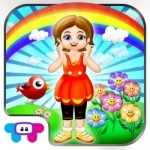
If you’re happy & you know it - Sing Along
Education and Games
App
-> Full Interactive Song + 9 Amazing Educational Games Inside -> Top HD graphics and superb musical...

iTalk Arabic: Conversation guide - Learn to speak a language with audio phrasebook, vocabulary expressions, grammar exercises and tests for english speakers
Education and Travel
App
▶ Speak Arabic with perfect native accent, in no time! ▶ Record your voice and hear what an...
